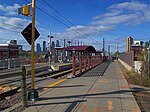Martin Olav Sabo Bridge

The Martin Olav Sabo Bridge is a bridge in the city of Minneapolis and the first cable-stayed suspension bridge in the U.S. state of Minnesota. Formerly the Midtown Greenway Pedestrian Bridge, it was renamed in honor of former Representative Martin Olav Sabo, a fourteen-term member of Congress from Minnesota. Opened and dedicated in November 2007, the bridge crosses Hiawatha Avenue (Trunk Highway 55) north of 28th Street East and just south of 26th Street East, joining Phase 2 and Phase 3 of the Minneapolis Midtown Greenway at Hiawatha Avenue, allowing a continuous biking connection across the city. The bridge also links Longfellow community (Longfellow and Seward neighborhoods) to Phillips community (East Phillips neighborhood), and connects users to the north-south Hiawatha LRT Trail and Little Earth Trail. The bridge was built by Hennepin County and transferred to the City of Minneapolis, which owns and maintains the bridge.The bridge was closed on February 20, 2012 when two of the cables that support the bridge fell due to cracks in their attachment points; additional significant cracks were subsequently found in two other support plates. The bridge, supported with temporary bracing, was reopened June 1, 2012. A summary report of the failure analysis released June 8, 2012 determined that unaccounted for wind-induced cable vibrations led to the failures of the attachment points. The bridge was again closed for repairs on September 23, 2012. Repairs were completed, and the bridge reopened, on November 19, 2012.
Excerpt from the Wikipedia article Martin Olav Sabo Bridge (License: CC BY-SA 3.0, Authors, Images).Martin Olav Sabo Bridge
Hiawatha Avenue, Minneapolis Seward
Geographical coordinates (GPS) Address Nearby Places Show on map
Geographical coordinates (GPS)
| Latitude | Longitude |
|---|---|
| N 44.9547 ° | E -93.2425 ° |
Address
Hiawatha Avenue 2649
55406 Minneapolis, Seward
Minnesota, United States
Open on Google Maps






